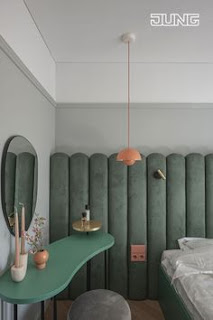Transforming Healthcare Spaces: Interior Design in Medical Centers, Hospitals, and Clinics. 8 Key Rules for Success
In the realm of healthcare, interior design plays a crucial role in creating spaces that promote healing, comfort, and efficiency. Gone are the days of sterile and unwelcoming environments; today's medical centers, hospitals, and clinics are embracing innovative design concepts to enhance patient experience and staff satisfaction.
Balancing Functionality and Aesthetics
Designing healthcare spaces involves striking a delicate balance between functionality and aesthetics. While practical considerations such as infection control, workflow efficiency, and accessibility remain paramount, there is a growing recognition of the importance of creating environments that are visually appealing and calming for patients and visitors.
Creating Healing Environments
Research has shown that well-designed healthcare environments can have a positive impact on patient outcomes and overall well-being. Incorporating elements of nature, such as natural light, greenery, and views of outdoor spaces, can help reduce stress and anxiety levels among patients. Additionally, thoughtful use of color, texture, and artwork can contribute to a sense of warmth and comfort in clinical settings.
Innovative Design Solutions
In recent years, there has been a shift towards more flexible and adaptable design solutions in healthcare design. Modular furniture, movable partitions, and multipurpose spaces allow for greater flexibility in accommodating changing needs and preferences. Technology integration is also becoming increasingly important, with features such as telemedicine facilities, digital signage, and smart lighting systems enhancing the patient experience.
Patient-Centered CareAt the heart of modern healthcare design is the principle of patient-centered care. This approach prioritizes the needs and preferences of patients, ensuring that the physical environment supports their healing journey. From private patient rooms with ample space for family members to comfortable waiting areas and intuitive wayfinding systems, every aspect of the design is tailored to enhance the patient experience.
Interior Design of Medical Centers: 8 Key Rules for Success
Remember the times when the interiors of medical centers and offices looked uniform: white sterile rooms that evoked boredom and a desire to escape.
Today, interior design of medical institutions receives no less attention than modern equipment, in order to create stylish, comfortable, high-tech spaces, with patient happiness at the center. Visiting such a clinic, patients will want to come back there and tell their friends about it. And this is a guarantee of high attendance and patient loyalty.
We have identified 8 main principles of medical center design that will help achieve such results.
- Create a Friendly Space in the Medical Center Interior
A visit to a medical center almost always causes anxiety. At the same time, properly selected colors and interior details can calm the patient:
- A unified color scheme in light tones creates the desired relaxed mood.
 Let in as much natural light as possible. It evokes pleasant sensations and instills a sense of calm.
Let in as much natural light as possible. It evokes pleasant sensations and instills a sense of calm.
- If there are children among the visitors, add bright accents to the medical center decor, as well as interactive elements that will uplift the mood and distract young patients from manipulations.
- Break Stereotypes in Medical Facility Design
 For a long time, medical centers were associated with long corridors where white empty walls evoked sadness. To break this stereotype, add paintings, decor, or other art objects to the reception area of the medical center.
For a long time, medical centers were associated with long corridors where white empty walls evoked sadness. To break this stereotype, add paintings, decor, or other art objects to the reception area of the medical center.
- Place live plants. This way, people will not feel like they are in a hospital, and the overall mood will be better.
- Create a Modern Hotel-Like Atmosphere in the Medical Center Interior
 In waiting areas, recovery zones, or meetings with friends and family, pay attention to all the amenities that a high-class hotel offers. The goal is to pamper patients, take care of their well-being, and show them how warmly they are welcomed. This approach is based on the firm belief that these aspects, including the medical center's environment, contribute to successful recovery.
In waiting areas, recovery zones, or meetings with friends and family, pay attention to all the amenities that a high-class hotel offers. The goal is to pamper patients, take care of their well-being, and show them how warmly they are welcomed. This approach is based on the firm belief that these aspects, including the medical center's environment, contribute to successful recovery.
- Build Patient Trust
 One of the objectives of a medical center is to earn the trust of its clients. A comfortable, functional space can contribute to this.
One of the objectives of a medical center is to earn the trust of its clients. A comfortable, functional space can contribute to this.
- Design the layout of the medical center to be as open as possible. Let patients see everything that does not violate others' boundaries. The less hidden from view, the higher the trust.
- Ensure that the staff and doctors have adequate workspace, including storage systems. Clinic staff will be more focused on their work when they can fully dedicate their attention to the patient.
- Use the design project of the medical center as an opportunity to communicate the values of your clinic. Hang paintings or posters in the corridors reflecting important ideas that guide clinic staff in their daily actions. These will create a strong connection between doctors and patients and serve as a daily reminder that subconsciously shapes desired behavior.
- Be Flexible in Planning the Medical Center Interior
Recent global epidemiological situations have shown how important it is to be able to adapt to new conditions when necessary.
- Choose modular furniture and mobile equipment whenever possible, allowing you to change the environment in the medical center without additional financial investments when requirements change.
- Pay attention to the width of the corridors during the overall planning of the medical center space. Even outside of pandemic conditions, this is an important aspect, as patients should be able to walk along the corridor without invading each other's personal space. In large medical center spaces, multiple corridors can be created. This will separate visitor and staff flows and reduce unwanted contacts.
- Emphasize Convenient Minimalism in Choosing the Interior Style of the Medical Center
 Cluttered, cluttered spaces will be as unpleasant to visitors as completely empty sterile rooms. To achieve the desired calm atmosphere in the interior of the medical center, it is worth choosing simplicity and modern design.
Cluttered, cluttered spaces will be as unpleasant to visitors as completely empty sterile rooms. To achieve the desired calm atmosphere in the interior of the medical center, it is worth choosing simplicity and modern design.
- Combine naturalness and technology. Clear lines, proper shapes, and the absence of massive large details create a sense of orderly space in a medical facility.
- Provide storage space. An adequate number of cabinets, shelves, and drawers will help hide all necessary tools, consumables, and documentation from prying eyes. Moreover, when each item has its place, work will be smooth and organized.
- Consider Legislative Requirements in Medical Center Design
 The minimum areas and requirements for rooms, treatment rooms, and other spaces in medical clinics are defined in the corresponding Swiss norms (e.g., DS 26.201 "Healthcare buildings - Planning and construction", DS 26.221 "Heating, ventilation and air conditioning systems", and other regulatory acts).
The minimum areas and requirements for rooms, treatment rooms, and other spaces in medical clinics are defined in the corresponding Swiss norms (e.g., DS 26.201 "Healthcare buildings - Planning and construction", DS 26.221 "Heating, ventilation and air conditioning systems", and other regulatory acts).
- All surfaces in medical centers must comply with sanitary and hygienic standards. Walls and furniture should be smooth. At the same time, the surface of medical furniture should be durable, resistant to chemical, physical, and temperature effects that occur during room and equipment treatment. Modern HPL panels, available in a variety of colors and textures, meet these requirements. It is worth paying attention to this material when ordering furniture for a medical institution.
- Choose Convenient and Durable Furniture for the Medical Center
 Remember that everyone who enters your medical center (both patients and doctors) should feel comfortable at every stage of interaction, from meeting the patient at the reception desk to visiting the doctor's office or paying at the cashier's desk. Comfort affects both the patient's impression of the clinic and the quality of staff work.
Remember that everyone who enters your medical center (both patients and doctors) should feel comfortable at every stage of interaction, from meeting the patient at the reception desk to visiting the doctor's office or paying at the cashier's desk. Comfort affects both the patient's impression of the clinic and the quality of staff work.
 Modular furniture allows you to almost instantly change the space as required by each specific situation.
Modular furniture allows you to almost instantly change the space as required by each specific situation.
- Anticipate in advance which cabinets in medical offices should be locked and install locks there. This will ensure the safety of tools, medicines, and documentation.
- Use only high-quality fittings that guarantee long-term operation in the conditions of increased loads of medical centers. This is especially true for mobile furniture.




















Comments
Post a Comment